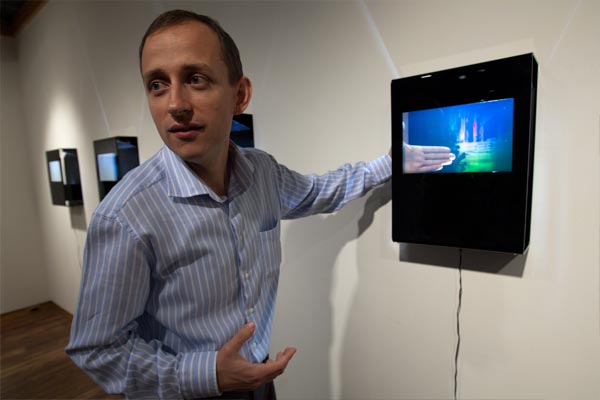
Is it art or is it science?
Published: November 16, 2011
The intersection of art and science jumps out at visitors to The Next Dimension, an exhibition of holograms created by University of Toronto students, on display in the U of T Art Centre’s Art Lounge through December 2.
The student creators are all veterans of an undergraduate holography course taught annually by Emanuel Istrate, a research associate and academic program co-ordinator for the Institute for Optical Sciences with the assistance of art professor Michael Page. Istrate notes that seeing a hologram in person is very different than seeing a photo and urges anyone with an interest to visit the exhibition. (Enjoy some photos of the holography exhibition.)
“I teach students to do technically sound work with an artistic meaning,” said Istrate as he walked around the exhibition.
His ideal for the course is a class composed of 50 per cent science students and 50 per cent arts students, and he finds that it’s a big draw for students from both types of disciplines.
“I want people who don’t normally work together to do so,” he said. “There’s too little contact between arts and science students; that’s the main reason I teach the course.
“You can lure people to holography who swore they would never study science again, and in the end, they ask very good questions during class, so they’re actually thinking about science and get it, but they wouldn’t have taken a science course.
“The science students, on the other hand, are really worried about the art thing. Science is clean; there are no arguments about the answers. More than 50 per cent of the grade for this course is based on real science questions, so they can be comfortable.”
Interestingly, the students learn the same principles taught in an optics class, but they absorb them while getting some hands-on experience. Holograms are essentially three-dimensional images stored in a two-dimensional medium – in this case, glass. They are created with lasers using a method Istrate says is very similar to working in a photography darkroom.
The images the students turn into holograms are first created using computer software that is used in Hollywood for 3-D animation. They make a laser print of that object by combining myriad 2-D images taken from different angles with the laser. Physics student Sarah Forward, along with her lab partner James Keane, created one of the show’s most popular images: a clock whose numbers appear to be flying off the face in all directions. (See a video depicting the 3-D nature of their hologram.)
"I wanted to create a hologram that illustrated Einstein's special relativity and allude to Salvador Dali's work, The Persistence of Memory," Forward said. "I chose to model a clock in the animation software 'Blender' that got thinner and changed its time as you moved from left to right. The thinning out of the clock represents Lorentz contraction and the time changes represent how there exists no absolute time in our universe, it depends on your frame of reference. The hologram includes 120 literal frames which let you in to see 120 different 'inertial reference frames'."
Keane was enthusiastic about his foray into holography.
“I thought holography sounded cool and I needed an elective course,” he said. “I’m really glad I took it. The course was really interesting. You get to learn about the science behind holograms, plus there’s an art component. I don’t usually get to do anything subjective, so this was cool.”
Philosophy student Bonnie Yang was also delighted by the course, since she was “looking for a physics course, but not full on physics.
“Here, I didn’t have to go into depth with all the calculations. It was more artistic, and I liked looking into another dimension. It was very sci fi.”



